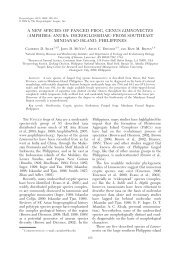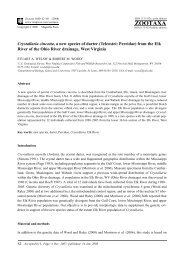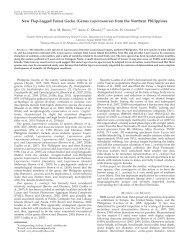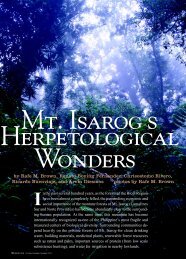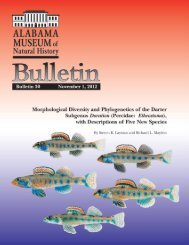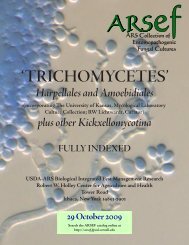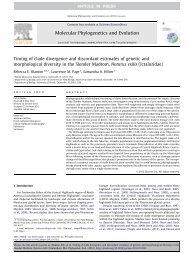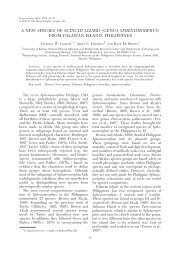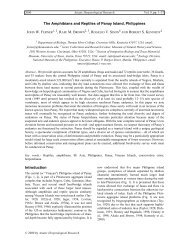Phylogeny-based species delimitation of southern Philippines bent
Phylogeny-based species delimitation of southern Philippines bent
Phylogeny-based species delimitation of southern Philippines bent
Create successful ePaper yourself
Turn your PDF publications into a flip-book with our unique Google optimized e-Paper software.
TERMS OF USEThis pdf is provided by Magnolia Press for private/research use.Commercial sale or deposition in a public library or website is prohibited.Zootaxa 2390: 49–68 (2010)www.mapress.com/zootaxa/Copyright © 2010 · Magnolia PressArticleISSN 1175-5326 (print edition)ZOOTAXAISSN 1175-5334 (online edition)<strong>Phylogeny</strong>-<strong>based</strong> <strong>species</strong> <strong>delimitation</strong> <strong>of</strong> <strong>southern</strong> <strong>Philippines</strong> <strong>bent</strong>-toed geckosand a new <strong>species</strong> <strong>of</strong> Cyrtodactylus (Squamata: Gekkonidae) from westernMindanao and the Sulu ArchipelagoLUKE J. WELTON 1 , CAMERON D. SILER 1,2 , ARVIN C. DIESMOS 2 & RAFE M. BROWN 1,21Natural History Museum & Biodiversity Institute, Department <strong>of</strong> Ecology and Evolutionary Biology, The University <strong>of</strong> Kansas,Lawrence, Kansas 66045-7561, USA.E-mail (LJW): furcifer@ku.edu; (RMB): rafe@ku.edu; (CDS) camsiler@ku.edu2National Museum <strong>of</strong> the <strong>Philippines</strong>, Rizal Park, Padre Burgos Ave. Ermita 1000, Manila, <strong>Philippines</strong>.E-mail: arvincdiesmos@i-manila.com.phAbstractUsing a combination <strong>of</strong> fixed morphological character differences, mitochondrial DNA sequence data, and an estimate <strong>of</strong>phylogeny as our guide, we describe a new <strong>species</strong> <strong>of</strong> <strong>bent</strong>-toed gekkonid lizard (Genus: Cyrtodactylus) fromsouthwestern Mindanao Island, and northeastern portions <strong>of</strong> the Sulu Archipelago, <strong>southern</strong> <strong>Philippines</strong>. The new<strong>species</strong> resembles C. annulatus, but differs from this and all other congeners by characteristics <strong>of</strong> external morphology,color pattern, and body size. In addition, the new <strong>species</strong> is distinguished from congeners by marked genetic divergenceand reciprocal monophyly <strong>of</strong> mitochondrial DNA sequences. The new <strong>species</strong> is common in pristine, low elevationgallery forests throughout Pasonanca Natural Park, Zamboanga Peninsula, southwestern Mindanao Island, and thenortheastern portions <strong>of</strong> the Sulu Archipelago.Key words: New <strong>species</strong>; Cyrtodactylus; geckos; Mindanao; Pasonanca Natural Park; <strong>Philippines</strong>; ZamboangaIntroductionPhilippine lizards <strong>of</strong> the family Gekkonidae include 10 genera and 40 or 41 <strong>species</strong>: Gehyra (1), Gekko (11when the doubtful record <strong>of</strong> G. hokouensis is excluded; Ota et al. 1989; Brown et al. 2008, 2009; Roesler et al.2006), Hemidactylus (5), Hemiphylodactylus (1), Lepidodactylus (6), Luperosaurus (6), Ptychozoon (1),Pseudogekko (4), and Cyrtodactylus (5), (Taylor 1922a, b; Brown & Alcala 1978; Brown et al. 2007; Gaulkeet al. 2007; Welton et al. 2009). A single record from Mindanao for Perochirus ateles (Duméril 1856;Boulenger 1885; Taylor 1922a; Brown & Alcala 1978) has not been confirmed in the last 150 years, but solittle work has been conducted in western Mindanao, that it is currently impossible to evaluate the status <strong>of</strong>this <strong>species</strong> in the <strong>Philippines</strong>.New <strong>species</strong> <strong>of</strong> Cyrtodactylus are being described regularly (Bauer 2003; Batuwita & Bahir 2005;Grismer 2005; Grismer & Leong 2005; Grismer & Norhayarti 2008; Grismer et al. 2008; Hayden et al. 2008;Kraus 2008; Linkem et al. 2008; Tri et al. 2008; Welton et al. 2009). To date, approximately 115 <strong>species</strong> havebeen described (TIGR Reptile database 2009), five <strong>of</strong> which constitute the assemblage <strong>of</strong> endemic PhilippineCyrtodactylus (i.e., Cyrtodactylus annulatus, C. agusanensis, C. philippinicus, C. redimiculus, and a recentlydescribed <strong>species</strong>, C. tautbatorum, from <strong>southern</strong> Palawan; Welton et al. 2009).Cyrtodactylus annulatus (Taylor) and C. philippinicus (Steindachner) are considered “widely distributed”on numerous islands throughout the archipelago (Brown & Alcala 1978), whereas C. agusanensis (Taylor)and C. redimiculus King are endemic to the southeastern (Samar, Leyte and eastern Mindanao islands) andsouthwestern (Palawan Island) portions <strong>of</strong> the archipelago, respectively. Currently, several additionalmorphologically distinct <strong>species</strong> <strong>of</strong> Philippine Cyrtodactylus await description (RMB and CDS, unpublishedAccepted by A. Bauer: 4 Jan. 2010; published: 5 Mar. 2010 49
TERMS OF USEThis pdf is provided by Magnolia Press for private/research use.Commercial sale or deposition in a public library or website is prohibited.data). The widespread (Brown & Alcala 1978) and biogeographically nonsensical (Brown & Diesmos 2002,2009) distributions <strong>of</strong> C. philippinicus and C. annulatus suggest that these <strong>species</strong> may represent complexes<strong>of</strong> phenotypically similar but evolutionarily distinct <strong>species</strong> (Brown & Guttman 2002; Evans et al. 2003;Gaulke et al. 2007; Siler et al. in press).Brown and Alcala (1978) delineated the distribution <strong>of</strong> Cyrtodactylus annulatus across several distinctPleistocene Aggregate Island Complexes (PAICs; Brown & Guttman 2002; Brown & Diesmos 2002)including the Mindanao, Sulu, Visayan, and Palawan island complexes (Brown & Alcala 1978; Fig. 1).Because many Philippine endemics conform to these regional faunistic boundaries (Brown et al. 2000a, 2002;Gaulke et al. 2007) we have begun the process <strong>of</strong> scrutinizing such “widespread” <strong>species</strong> in an effort todiagnose any additional evolutionary lineages. This work has led to the discovery <strong>of</strong> a distinct <strong>species</strong> <strong>of</strong>Cyrtodactylus from <strong>southern</strong> Palawan (Welton et al. 2009), clarified the status and distribution <strong>of</strong> true C.annulatus, and uncovered a distinct western Mindanao and Sulu Archipelago lineage, which is the subject <strong>of</strong>this paper.Taylor (1922a) recognized non-overlapping character differences between allopatric populations <strong>of</strong> C.annulatus but for reasons unknown, did not name them as distinct <strong>species</strong>. He wrote: “It was noted thatspecimens from various islands showed slight differences, especially in the arrangement and size <strong>of</strong> thepreanal pores and scales surrounding them. Specimens from [the] Sulu have an average <strong>of</strong> only four preanalpores” (Taylor 1922a:46). Upon close examination <strong>of</strong> specimens <strong>of</strong> “C. annulatus” from the ZamboangaPeninsula, western Mindanao, Basilan Island, and Jolo Island, coupled with an analysis <strong>of</strong> molecular variationthroughout the range <strong>of</strong> populations formerly referred to C. annulatus, it has become clear that the isolatedpopulations at the tip <strong>of</strong> the Zamboanga Peninsula and the closely adjacent Sulu Archipelago represent adistinct evolutionary lineage. This lineage is identifyable because <strong>of</strong> the presence <strong>of</strong> morphologicaldifferences between it and C. annulatus which are consistent across large series <strong>of</strong> specimens. This fact,combined with the relatively high levels <strong>of</strong> genetic divergence and allopatric distributions on differentgeological components <strong>of</strong> Mindanao Island (Yumul et al. 2009), compel us to describe the Zamboanga andSulu population as a new <strong>species</strong>. In this paper we identify the diagnostic characters that, coupled withreciprocally monophyletic, highly divergent mitochondrial sequence variation and biogeographicalconsiderations, allow the diagnosis <strong>of</strong> these populations as a new <strong>species</strong>.Materials and methodsMorphological data. We scored data from fluid-preserved specimens deposited in U.S. and Philippinecollections (see Acknowledgments and Specimens Examined). Sex was determined by inspection <strong>of</strong> gonadsor by scoring <strong>of</strong> prominent secondary sexual characteristics (Brown et al. 1997, 2000b; Brown 1999) whendissection was not possible. Measurements (to the nearest 0.1 mm) were taken with digital calipers followingcharacter definitions by Ota and Crombie (1989) and Brown et al. (1997), as modified by Brown (1999) andBrown et al. (2007). Characters include: snout–vent, snout, head, hand, forearm, upper arm, foot, tibia-fibula,femur, and tail lengths; head and tail widths, and heights; eye diameter; eye–naris, internarial, interorbital,eye–ear, and axilla–groin distances; Toes I and IV, and Fingers I and III lengths; scale counts <strong>of</strong> supralabialsand infralabials to the center <strong>of</strong> the eye and posteriorly to the terminus <strong>of</strong> differentiation; enlargedcircumorbitals dorsoanterior to orbit; transverse midbody dorsals and ventrals; paravertebrals through axillagroinregion; pore-bearing precloacals and pore-bearing prean<strong>of</strong>emorals (or enlarged pore-less scales infemales); postmentals; transverse midbody tubercle rows, paravertebral tubercles; postcloacal tubercles;subdigital lamellae <strong>of</strong> fingers and toes; transverse midbody tubercle rows; paravertebral tubercles throughaxilla–groin region; tail annuli; subcaudals; and number <strong>of</strong> transverse bands in the axilla-groin region.Additional qualitative characters included predominant color pattern; number, size, and shape <strong>of</strong> transversebands across the body; dorsolateral tubercle coloration; and supraciliary scale series coloration.Molecular data. The ingroup sampling strategy included 24 individuals collected from 10 localities,with sampling spanning the known distribution <strong>of</strong> the currently recognized <strong>species</strong> Cyrtodactylus annulatus50 · Zootaxa 2390 © 2010 Magnolia PressWELTON ET AL.
TERMS OF USEThis pdf is provided by Magnolia Press for private/research use.Commercial sale or deposition in a public library or website is prohibited.as well as the recently discovered <strong>species</strong> Cyrtodactylus tautbatorum from Palawan (Welton et al. 2009;Table 1). Two samples <strong>of</strong> Cyrtodactylus baluensis were included as outgroups in the analyses. For all 26samples, the mitochondrial gene NADH Dehydrogenase Subunit 2 (ND2) and components <strong>of</strong> six flankingtransfer RNA genes (tRNA met , tRNA trp , tRNA ala , tRNA asn , tRNA cys , and tRNA tyr ) were sequenced. Allsequences were deposited in GenBank under accession numbers provided in Table 1.DNA extractions, PCR, and purification protocols. Genomic DNA was extracted from liver tissuesstored in 95–100% ethanol following the guanidine thiocyanate method <strong>of</strong> Esselstyn et al. (2008). Theexternal primers Metf6 (5'-AAGCTTTCGGGCCCATACC-3') and CO1H (5'-AGRGTGCCAATGTCTTTGTGRTT-3') were used to amplify the target fragment using the polymerase chainreaction (PCR), and were taken from Macey et al. (1999). We used the following thermal cycler pr<strong>of</strong>ile forND2: 4 min at 94 º , followed by 35 cycles <strong>of</strong> 94 º for 30 sec, 52–53 º for 30 sec, and 72 º for 1 min 30 sec, and afinal extension phase at 72 º for 7 min. Amplified products were visualized on 1.0% agarose gels. The PCRproduct was purified with 1 µL <strong>of</strong> a 20% diluted solution <strong>of</strong> ExoSAP-IT (US78201, Amersham Biosciences,Piscataway, NJ) on the following thermal cycler pr<strong>of</strong>ile: 31 min at 37 º , followed by 15 min at 80 º . Cyclesequencing reactions were run using ABI Prism BigDye Terminator chemistry (Ver. 3.1; Applied Biosystems,Foster City, CA), and purified with Sephadex (NC9406038, Amersham Biosciences, Piscataway, NJ) inCentri-Sep 96 spin plates (CS-961, Princeton Separations, Princeton, NJ). Additionally, we designed internalprimers [CyrtInt.F1 (5'- TAGCCYTCTCYTCYATYGCCC -3') and CyrtInt.R1 (5'-ATTGTKAGDGTRGCYAGGSTKGG -3')] for cycle sequencing. All samples were sequenced in bothforward and reverse directions. Purified products were analyzed with an ABI Prism 3130xl Genetic Analyzer(Applied Biosystems). Consensus gene sequences were assembled and initially edited using Sequencher 4.8(Gene Codes Corp., Ann Arbor, MI).Alignment and phylogenetic analysis. An initial alignment was produced in Muscle v3.7 (Edgar 2004),and manual adjustments were made in MacClade 4.08 (Maddison & Maddison 2005). Phylogenetic analyseswere conducted using parsimony, likelihood and Bayesian optimality criteria. Parsimony analyses wereconducted in PAUP* 4.0b10a (Sw<strong>of</strong>ford 2002) with gaps treated as missing data and all characters weightedequally. Most parsimonious trees were estimated using heuristic searches with 1000 random additionsequencereplicates and tree bisection and reconnection (TBR) branch swapping. We assessed clade supportwith 1000 nonparametric bootstrap replicates, each with 100 random addition-sequence replicates and TBRbranch swapping.Partitioned maximum likelihood (ML) analyses were conducted in RAxMLHPC v7.0 (Stamatakis 2006).The dataset was partitioned by codon position for the protein-coding region <strong>of</strong> ND2, and the six flankingtRNAs (tRNA met , tRNA trp , tRNA ala , tRNA asn , tRNA cys , and tRNA tyr ) were analyzed as a single partition. TheAkaike Information Criterion (AIC) as implemented in Modeltest v3.7 (Posada & Crandall 1998) was used t<strong>of</strong>ind appropriate models <strong>of</strong> evolution for our data. The best-fit model for each <strong>of</strong> the four partitions <strong>of</strong> themitochondrial data was the general time reversible (GTR) model, with a proportion <strong>of</strong> invariable sites (I) anda parameter for variation in rates among sites (Γ). Partitioned ML analyses were then run under the closestmodel approximation available in RAxMLHPC v7.0 (GTR MIX) with 100 replicate best tree inferences.Clade support was assessed with 1000 bootstrap pseudoreplicates.Partitioned Bayesian analyses were performed in MrBayes 3.1 (Ronquist & Huelsenbeck 2003) under theGTR + I + model for the mitochondrial dataset. The same partitioning strategy used for maximum likelihoodanalyses was also used for the Bayesian analyses. Searches over tree space were conducted with four runs,each with four chains, and were run for 10 × 10 6 generations. Trees were sampled every 1000 generations,with 2000 samples discarded as burn-in, this left 8001 post-burnin trees from each run included in thesummary. Visual inspection for chain stationarity was conducted with the program Tracer v1.4 (Rambaut &Drummond 2007).Species concept. We embrace the General Lineage Concept <strong>of</strong> <strong>species</strong> (de Queiroz 1998 1999) as alogical extension <strong>of</strong> the Evolutionary Species Concept (Simpson 1961; Wiley 1978). We use an estimate <strong>of</strong>phylogenetic relationships to guide <strong>species</strong> <strong>delimitation</strong> and identification <strong>of</strong> relevant comparisons for <strong>species</strong>diagnoses. We consider as distinct <strong>species</strong> lineages that are morphologically and genetically distinct, and forNEW WESTERN MINDANAO CYRTODACTYLUSZootaxa 2390 © 2010 Magnolia Press · 51
which the hypothesis <strong>of</strong> conspecificity can be confidently rejected by analyses <strong>of</strong> morphological and geneticdata.TABLE 1. Specimens corresponding to genetic samples included in the phylogenetic analysis, general locality, andGenBank accession number. * = deposited in the National Museum <strong>of</strong> the <strong>Philippines</strong>; **; = deposited in the CincinnatiMuseum <strong>of</strong> Natural History; ***= holotype.SpeciesTERMS OF USEThis pdf is provided by Magnolia Press for private/research use.Commercial sale or deposition in a public library or website is prohibited.MuseumCatalog No.LocalityGenBankAccession No.C. baluensis SP 06891 Malaysia, Borneo, Sabah, Mt. Kinabalu National Park, Headquarters GU 366079C. baluensis SP 06906 Malaysia, Borneo, Sabah, Mt. Kinabalu National Park, Headquarters GU 366080C. tautbatorum KU 309319 <strong>Philippines</strong>, Palawan Island, Palawan Province, Municipality <strong>of</strong> Brooke’s GU 366083PointC. tautbatorum KU 309320 <strong>Philippines</strong>, Palawan Island, Palawan Province, Municipality <strong>of</strong> Brooke’s GU 366082PointC. tautbatorum KU 309321 <strong>Philippines</strong>, Palawan Island, Palawan Province, Municipality <strong>of</strong> Brooke’s GU 366081PointC. annulatus ACD 2661* <strong>Philippines</strong>, Mindanao Island, Eastern Mindanao, Diwata Mountain GU 366084Range.C. annulatus ACD 2637* <strong>Philippines</strong>, Mindanao Island, Eastern Mindanao, Diwata Mountain GU 366085Range.C. annulatus PNM/CMNH H-1646**<strong>Philippines</strong>, Mindanao Isl., South Cotobato Prov., Municipality <strong>of</strong>Kiamba, Barangay Banate, Mt. BusaGU 366086C. annulatus PNM/CMNH H-1503**<strong>Philippines</strong>, Mindanao Isl., South Cotobato Prov., Municipality <strong>of</strong>Kiamba, Barangay Banate, Mt. BusaGU 366087C. annulatus KU 314944 <strong>Philippines</strong>, Mindanao Isl., Agusan del Sur Prov., Municipality <strong>of</strong> San GU 366088Francisco, Barangay Kaimpugan, Agusan MarshC. annulatus KU 314945 <strong>Philippines</strong>, Mindanao Isl., Agusan del Sur Prov., Municipality <strong>of</strong> San GU 366089Francisco, Barangay Kaimpugan, Agusan MarshC. annulatus KU 311157 <strong>Philippines</strong>, Leyte Island, Leyte Province, Municipality <strong>of</strong> Baybay GU 366090C. annulatus PNM 1417 <strong>Philippines</strong>, Leyte Island, Leyte Province, Municipality <strong>of</strong> Baybay GU 366091C. annulatus KU 305567 <strong>Philippines</strong>, Cebu Island, Cebu Province, Municipality <strong>of</strong> Alcoy GU 366092C. annulatus KU 305568 <strong>Philippines</strong>, Cebu Island, Cebu Province, Municipality <strong>of</strong> Alcoy GU 366093C. annulatus TNHC 56457 <strong>Philippines</strong>, Siquijor Island, Siquijor Province, Muncipality <strong>of</strong> San Juan, GU 366094Barangay Kang-adiangC. annulatus TNHC 56467 <strong>Philippines</strong>, Bohol Island, Bohol Province, Municipality <strong>of</strong> Camern, GU 366095Barangay RiversideC. annulatus RMB 2881* <strong>Philippines</strong>, Bohol Island, Bohol Province, Municipality <strong>of</strong> Bilar, GU 366096Barangay LogaritaC. annulatus PNM 1474 Mindanao Isl., Agusan del Norte Prov., Diuata Mountain Range GU 366097C. annulatus KU 309363 <strong>Philippines</strong>, Camiguin Sur Island, Camiguin Province, Municipality <strong>of</strong> GU 366099MambajaoC. annulatus KU 309365 <strong>Philippines</strong>, Camiguin Sur Island, Camiguin Province, Municipality <strong>of</strong> GU 366098MambajaoC. jambangan KU 314793 <strong>Philippines</strong>, Mindanao Island, Zamboanga del Sur Prov., Municipality <strong>of</strong> GU 366100Pasonanca, Pasonanca Natural Park, Tumaga RiverC. jambangan KU 314806 <strong>Philippines</strong>, Mindanao Island, Zamboanga del Sur Prov., Municipality <strong>of</strong> GU 366101Pasonanca, Pasonanca Natural Park, Tumaga RiverC. jambangan KU 314835 <strong>Philippines</strong>, Mindanao Island, Zamboanga del Sur Prov., Municipality <strong>of</strong>Pasonanca, Pasonanca Natural Park, Tumaga RiverGU 366102C. jambangan PNM 9593; KU314810***<strong>Philippines</strong>, Mindanao Island, Zamboanga del Sur Prov., Municipality <strong>of</strong>Pasonanca, Pasonanca Natural Park, Baragnay Baluno, Sitio Kilometer 24C. jambangan KU 314823 <strong>Philippines</strong>, Mindanao Island, Zamboanga del Sur Prov., Municipality <strong>of</strong>Pasonanca, Pasonanca Natural Park, Baragnay Baluno, Sitio Kilometer 24GU 366103GU 36610452 · Zootaxa 2390 © 2010 Magnolia PressWELTON ET AL.
TERMS OF USEThis pdf is provided by Magnolia Press for private/research use.Commercial sale or deposition in a public library or website is prohibited.FIGURE 1. The potential distribution <strong>of</strong> Cyrtodactylus annulatus in the <strong>southern</strong> and central <strong>Philippines</strong> (left, darklyshaded islands), known C. annulatus localities on Mindanao Isl. (right, black circles; square = Bunawan, type locality),the distribution <strong>of</strong> C. tautbatorum from Palawan (Welton et al. 2009; left, diamond, <strong>southern</strong> Palawan) and knowlocalities for C. jambangan, n. sp. (the type locality indicated with a star; additional localities substantiated withspecimens encircled with dashed line). The question mark adjacent to Tawi-tawi Island indicates uncertainty withrespect to the taxonomic status <strong>of</strong> the Cyrtodactylus <strong>of</strong> the southwestern Sulu Archipelago. The occurrence <strong>of</strong>Cyrtodactylus from these islands was reported by Taylor (1922; as C. annulatus), but specimens from <strong>southern</strong> SuluArchipelago islands currently are not available in collections. The single dark spot north <strong>of</strong> Mt. Malingdang at the base<strong>of</strong> the Zamboanga peninsula is the westernmost locality for true C. annulatus.ResultsMorphological data. Body size and other continuously varying morphometric characters showedoverlapping ranges <strong>of</strong> variation among sampled localities (Tables 2, 3). Slight differences were detected inmeristic characters (precloacal pore number, number <strong>of</strong> enlarged scale rows anterior to the cloacal region;Table 2). We noted no mensural or meristic differences between sexes <strong>of</strong> C. annulatus and C. tautbatorum(Table 3) except that C. annulatus specimens, on average, are larger than the new <strong>species</strong> (Fig. 3). However,we noted fixed differences in color patterns, with the Zamboanga and Sulu populations <strong>of</strong> the new <strong>species</strong>described here differing from all populations <strong>of</strong> C. annulatus. These included a faded, dark, marbled colorpattern, reduction in contrast between light and dark transverse body bands, bright yellow dorsolateral trunktubercles, a yellow canthal stripe, and bright yellow superciliaries (See color description <strong>of</strong> new <strong>species</strong>,below; Figs. 3, 5).Molecular data. Of the 1423 characters, 321 were parsimony-informative. Uncorrected pairwisesequence divergences between C. annulatus populations and C. tautbatorum ranged from 11.4–12.3% (mean=11.8%), and between C. annulatus and C. n. sp. from Zamboanga and Sulu sequence divergences varied from7.9–9.5% (mean = 8.6%; Table 1). We provide these genetic distances as general, demonstrative measures <strong>of</strong>evolutionary divergence and isolation, but we do not use them as criteria for recognizing <strong>species</strong> (seeTaxonomic Conclusions, below).<strong>Phylogeny</strong>. Parsimony, ML, and Bayesian inferences all yielded the same interspecific topology, withonly minor differences in the placement <strong>of</strong> individuals within <strong>species</strong> (Fig. 2). Three major monophyleticmitochondrial lineages were recovered, each strongly supported in all analyses (Fig. 2). Of these, one lineagefrom Palawan (formerly considered an allopatric population <strong>of</strong> C. annulatus; Brown & Alcala 1978) is sisterto all remaining C. annulatus populations. This lineage is the morphologically distinct, newly described<strong>species</strong> C. tautbatorum (Welton et al. 2009). Another, more widespread, lineage corresponds to true C.annulatus and consists <strong>of</strong> populations from throughout Mindanao, Cebu, Siquijor, Camiguin Sur, Bohol, andLeyte islands (Fig. 1)—a distribution enumerated by Taylor (1922a) and Brown and Alcala (1978). We areconfident <strong>of</strong> the correct assignment <strong>of</strong> the name C. annulatus to this clade because it includes gene sequencesderived from the type locality for C. annulatus (Bunawan, Agusan Province, Mindanao Isl.; Taylor 1922a).The clade most closely related to C. annulatus is a divergent, reciprocally monophyletic lineage from the tipNEW WESTERN MINDANAO CYRTODACTYLUSZootaxa 2390 © 2010 Magnolia Press · 53
TERMS OF USEThis pdf is provided by Magnolia Press for private/research use.Commercial sale or deposition in a public library or website is prohibited.<strong>of</strong> the Zamboanga Peninsula (and presumably Basilan Island and parts <strong>of</strong> the Sulu Archipelago). Asdiscussed above, the Sulu Archipelago + Zamboanga form was first identified as morphologically distinct byTaylor (1922a, b) but not described at that time.FIGURE 2. The preferred phylogenetic estimate for C. annulatus group <strong>species</strong>, inferred in partitioned Bayesian andlikelihood analyses, and equally weighted parsimony analyses <strong>of</strong> ND2 sequence data. Numbers adjacent to nodes arelikelihood and parsimony bootstraps, and Bayesian posterior probability support values, respectively.Taxonomic conclusions. Despite the absence <strong>of</strong> statistically significant, non-overlapping variation inbody size and mensural characters, we note consistent, non-overlapping, and thus diagnostic, character statedifferences in meristic characters <strong>of</strong> scalation and color pattern <strong>of</strong> the Zamboanga and Sulu Archipelagopopulations. These characters unambiguously diagnose the new <strong>species</strong> from the widely distributed C.annulatus, the newly discovered C. tautbatorum from <strong>southern</strong> Palawan (Welton et al. 2009), and all otherPhilippine (Table 2) and morphologically relevant (Table 3) congeners. This suite <strong>of</strong> diagnostic characterstates corresponds to a genetically divergent, monophyletic mitochondrial gene lineage, which furthersupports the need to recognize this population as a distinct taxonomic entity. Based on our examination <strong>of</strong>specimens from throughout the <strong>southern</strong> <strong>Philippines</strong>, we assign northeast Sulu Archipelago populations to thenew <strong>species</strong> as well.Species descriptionCyrtodactylus jambangan sp. nov.Figs. 3–5Holotype. PNM 9593 (formerly KU 314810, RMB Field No. 10,005), adult male, collected on the trunk <strong>of</strong> asapling (20:00–23:00) in Pasonanca Natural Park, Barangay Baluno, Zamboanga City Province, MindanaoIsland, <strong>Philippines</strong> (N: 07º 1.0554, E: 122º 1.731, WGS-84; 758 m above sea level), on 12 July, 2008 by L.54 · Zootaxa 2390 © 2010 Magnolia PressWELTON ET AL.
TERMS OF USEThis pdf is provided by Magnolia Press for private/research use.Commercial sale or deposition in a public library or website is prohibited.Welton, R. Brown, C. Siler, J. Fernandez, M. and V. Yngente, and J. Phenix.Paratopotypes. Four males (KU 314813, 314815, 314825, and 314828), fourteen females (KU 314808,314811, 314816–18, 314820, 3134822–24, 314826–27, and 314829–31), and five juveniles (KU 314809,314812, 314814, 314819, and 314821) collected on the trunks <strong>of</strong> trees (18:00–23:00), 12–18 July 2008, otherdata identical to holotype.Paratypes. Four males (KU 314793–94 and 314796–97), two females (KU 314795 and 314798), andthree juveniles (KU 314792, and 314833–34), collected 7 July 2008, in Pasonanca Natural Park, TumagaRiver (N: 6º 35.174, E: 122º 2.426, 94m, WGS-84), by L. Welton, R. Brown, C. Siler, J. Fernandez, M. and V.Yngente, and J. Phenix; one male (KU 314835), one female (KU 314806), and one juvenile (KU 314799),collected 8 July 2008, in Pasonanca Natural Park, Tumaga River (N: 6º 58.624, E: 122º 3.043, 104m, WGS-84), by the same collectors; two males (KU 314807 and 314836) collected 9–11 July 2008, in PasonancaNatural Park, Tumaga River (N: 6º 59.534, E: 122º 3.626, 94m, WGS-84), by the same collectors; two males(KU 314803 and 314805), one female (KU 314804), and three juveniles (KU 314800–02), collected 9 July2008, Pasonanca Natural Park, Tumaga River (N: 6º 58.624, E: 122º 4.043, 104m, WGS-84), by the samecollectors; two males (KU 314781 and 314784), one female (KU 314780), and four juveniles (KU 314778–79and 314782–83), collected 20–22 April 2008, in Pasonanca Natural Park, Barangay Pasonanca, SitioCanucutan (N: 6º 59.534, E: 122º 3.626, 104m, WGS-84), by R. Brown and A. Diesmos; one male (KU319654), one female (KU 319655), and one juvenile (KU 319652), collected 3–5 April 2009, in PasonancaNatural Park, Barangay La Paz, Sitio Nancy (N: 7º 5.099, E: 122º 1.620, 1130m, WGS-84), by R. Brown, C.Infante, and A. Diesmos; two males (KU 319656 and 319657), collected 6–9 April 2009, in PasonancaNatural Park, Barangay Tulosa, Sitio Santa Clara, Cabo Negros outpost (N: 7º 6.479, E: 122º 7.139, 620m,WGS-84), by the same collectors; three males (KU 319660–62), and one female (KU 319658), collected 11April 2009, in Pasonanca Natural Park, Tumaga River (N: 6º 35.174, E: 122º 2.426, 94m, WGS-84), by thesame collectors; twelve males (CAS 60195, 60197, 60199, 60203–205, 60208, 60212, 60217–18, 60221, and60453), 15 females (CAS 60196, 60200–201, 60207, 60209–10, 60213–16, 60220, 60454–55, 60458, and60460), and six juveniles (CAS 60222–24, 60456–57, and 60459) collected at Abung-Abung and PortHolland on Basilan Island, 5–25 October, 1921, by E. H. Taylor; two males (CAS 60622–23), three females(CAS 60619–21), and one juvenile (CAS 60624) collected on New Govenen Island, 5–25 October, 1920, byE. H. Taylor; one male (CAS 60669), four females (CAS 60670–72 and 60887), and two juveniles (CAS60886 and 60888) collected on Bud Daho Mt. on Jolo Island, 25 October–17 November, 1920, by E. H.Taylor; two males (CAS 62020 and 62022), three females (CAS 62017, 62019, and 62021), and one juvenile(CAS 62018) collected in Zamboanga del Sur Province, 23 September–6 October, 1920, by E. H. Taylor.Diagnosis. The new <strong>species</strong> differs from most <strong>of</strong> Asia’s 115 Cyrtodactylus <strong>species</strong> by the same suite <strong>of</strong>character states that has facilitated the recognition and distinction <strong>of</strong> C. annulatus: (1) small body size; (2)light gray body, with dark transverse bands; (3) presence <strong>of</strong> a weak precloacal groove; (4) absence <strong>of</strong> enlargedfemoral scales and pores; (5) moderately spinose tuberculation; (6) presence <strong>of</strong> forelimb tuberculation; (7) andabsence <strong>of</strong> enlarged, median subcaudal scales (Taylor 1922; Brown & Alcala 1978; Manthey & Grossman1997; Grismer 2005; Welton et al. 2009). Because the new <strong>species</strong> differs from non-Philippine congeners bycharacters that have distinguished C. annulatus (and have never been challenged; Taylor 1922a; Brown &Alcala 1978), we do not provide exhaustive comparisons to all those <strong>species</strong> (see Welton et al. 2009). Insteadwe focus on the comparisons relevant for the recognition <strong>of</strong> the new <strong>species</strong>: the closely related taxa withinthe C. annulatus complex and other Cyrtodactylus endemic to the <strong>Philippines</strong>.Cyrtodactylus jambangan differs from all other <strong>species</strong> <strong>of</strong> Philippine Cyrtodactylus (i.e., C. agusanensis,C. philippinicus, C. redimiculus, and C. tautbatorum; Table 2) by the following combination <strong>of</strong> characters:(1) small body size (2) dorsum darkly marbled lavender and brown or brown with indistinct wavy lavenderblotches; (3) presence <strong>of</strong> bright yellow superciliaries, canthal stripe, and dorsal tubercles; (4) low dorsal scalecounts (as measured by midbody dorsal and paravertebral scales; Table 2); (5) moderate numbers <strong>of</strong> midbodydorsal tubercle rows (Table 2); (6) absence <strong>of</strong> femoral pores in both sexes; (7) presence <strong>of</strong> precloacal pores inmales and similarly enlarged, dimpled, scales in females, arranged in an inverted “V”-shaped configuration;(8) moderately depressed precloacal groove; (9) scales anterior to precloacal region undifferentiated; (10)lamellae under Finger III 17–22; (11) lamellae under Toe IV 20–24 (12) supralabials to beneath eye 8–11; (13)infralabials to beneath the eye 6–8; (14) absence <strong>of</strong> stripes connecting the lateral margins <strong>of</strong> transverse bandson trunk; and (15) midbody ventral scales 48–63. Comparisons with additional Southeast Asian <strong>species</strong> areprovided in Table 3.NEW WESTERN MINDANAO CYRTODACTYLUSZootaxa 2390 © 2010 Magnolia Press · 55
TERMS OF USEThis pdf is provided by Magnolia Press for private/research use.Commercial sale or deposition in a public library or website is prohibited.56 · Zootaxa 2390 © 2010 Magnolia PressWELTON ET AL.
TERMS OF USEThis pdf is provided by Magnolia Press for private/research use.Commercial sale or deposition in a public library or website is prohibited.NEW WESTERN MINDANAO CYRTODACTYLUSZootaxa 2390 © 2010 Magnolia Press · 57
TERMS OF USEThis pdf is provided by Magnolia Press for private/research use.Commercial sale or deposition in a public library or website is prohibited.FIGURE 3. Dorsal aspect <strong>of</strong> typical sized specimens <strong>of</strong> Cyrtodactylus annulatus (left: KU 309364; Camiguin Sur Isl.)and C. jambangan, n. sp., (right: holotype PNM 9593 specimen from Pasonanca, Zamboanga City Province).The critical comparison for the recognition <strong>of</strong> the new <strong>species</strong> is the diagnosis <strong>of</strong> the Zamboanga and Sulupopulations from true C. annulatus (type locality from the Municipality <strong>of</strong> Bunawan, Agusan Del SurProvince, Mindanao Island), and newly designated C. annulatus neotype locality (Welton et al. 2009) <strong>of</strong> Mt.Hilonghilong, Diwata Mountains, Agusan Del Norte Province, Mindanao Island. Although morphologicallysimilar to C. annulatus from throughout its range, C. jambangan has bright yellow canthal stripes,superciliaries, dorsal tubercles, and moderate-sized dorsolateral body tubercles, fewer precloacal pores,undifferentiated precloacals, and strongly spinose (versus moderate, domed) dorsal tuberculation. The new<strong>species</strong> is separated from C. annulatus by 7.9–9.5% (mean = 8.6%) uncorrected sequence divergence (Table4) in the ND2 protein-coding mitochondrial gene region (see Table 3 for complete univariate morphometricdata for C. annulatus and C. jambangan). The new <strong>species</strong> differs from all remaining Philippine <strong>species</strong> by avariety <strong>of</strong> morphological and color pattern characters (Table 2; Brown and Alcala 1978).Description <strong>of</strong> holotype. Adult male, snout–vent length 67.7 mm; head moderately long, distinct fromneck, 30.3% SVL; head width 64.7% and height 41.7% head length; head triangular in dorsal aspect; loresconcave; snout elongate, 41.7% head length, anterior tip rounded; eye diameter 20.6% head length, 76.3%eye–ear distance; auricular opening ovoid, longest axis 9.5% head length.Dorsal head scalation heterogenous, scales small and granular, with tubercle density sparse medially,tubercles increasing in size and density posteriorly and laterally; superciliaries increasing in size (laterallyelongated) anteriorly, with largest scales at anterodorsal margin <strong>of</strong> orbit; rostral taller than wide, divideddorsally by inverted “Y” shaped crease; rostral bordered by large, anterior internasal and smaller, pairedposterior internasals, supranasals, and first supralabials; internarial distance 2.2 mm; nostrils bordered bysupranasals, rostral, 2 postnasals, and first supralabials; supralabials rectangular, decreasing in size posteriorly(left/right): 9/10 to midpoint <strong>of</strong> eye, 12/12 total; infralabials 7/7 to midpoint <strong>of</strong> eye, 11/10 total; supralabials58 · Zootaxa 2390 © 2010 Magnolia PressWELTON ET AL.
TERMS OF USEThis pdf is provided by Magnolia Press for private/research use.Commercial sale or deposition in a public library or website is prohibited.bordered dorsally by secondary, slightly differentiated row <strong>of</strong> scales, extending to anterior margin <strong>of</strong> orbit;infralabials bordered ventrally by similar row, extending to anterior margin <strong>of</strong> orbit.FIGURE 4. Precloacal regions <strong>of</strong> (A) Cyrtodactylus jambangan, n. sp., and (B) C. annulatus (from Taylor 1922),showing the four-pour configuration typical <strong>of</strong> C. jambangan and the normal condition <strong>of</strong> six pores in C. annulatus.Note the presence <strong>of</strong> separated lateral patches <strong>of</strong> enlarged scales on either side <strong>of</strong> the precloacal pores (anteriorprecloacals undifferentiated or only slightly differentiated in C. jambangan) versus a continuous arc <strong>of</strong> greatly enlargedprecloacals in C. annulatus.Ventral head scalation heterogenous; mental bordered by first infralabials, and paired postmentals, withtriangular projection posteriorly; 7 differentiated gular scales posterior to postmentals; first infralabial incontact with postmental and single differentiated gular; remaining gulars heterogenous, small and granular,increasing in size in nuchal region.Body elongate, axilla–groin distance 44.5% snout–vent length, lacking distinct ventrolateral folds; dorsalscalation granular, heterogenous, with semi-regular rows <strong>of</strong> rounded, posteriorly-oriented tubercles,increasing in protuberance (from convex to conical) and size posterior to hind limb insertions; tubercles in 17longitudinal midbody and 27 paravertebral rows; paravertebral scales 164; transverse midbody dorsal andventral scales 91 and 54 respectively, between lateral tubercle rows; ventral scales imbricate, slightly largerthan dorsals and increasing in size medially; differentiated precloacals 4, arranged in an inverted “V”configuration pierced with enlarged pores, surrounding shallow and longitudinally short precloacal groove;two patches <strong>of</strong> enlarged scales anterolateral to precloacals (14 left, 13 right); two rows <strong>of</strong> slightly enlargedscales anterior to precloacals; three slightly enlarged scales posterior to precloacals.Forelimbs slender, forearm and upper arm 14.3% and 12.4% snout–vent length respectively; scalation ondorsal surfaces <strong>of</strong> forelimbs heterogenous, scales larger than ventrals; tubercles absent on upper arm, sparseon forearm, less spinose than dorsal trunk tubercles; ventral scalation homogenous, lacking tubercles; fingerswell developed; Fingers I and III 37.4% and 62.2% forearm length, respectively; lamellae enlarged andslightly raised, lamellae proximal to inflection larger than those distal to inflection, slight increase in size fromNEW WESTERN MINDANAO CYRTODACTYLUSZootaxa 2390 © 2010 Magnolia Press · 59
TERMS OF USEThis pdf is provided by Magnolia Press for private/research use.Commercial sale or deposition in a public library or website is prohibited.inflection to claw; finger number followed by subdigital lamellae (in parentheses): I (11), II (14), III (20), IV(18), V (15); all fingers clawed; claws well developed, sheathed by single dorsal and ventral scale.TABLE 4. Summary <strong>of</strong> univariate morphological variation among mensural and meristic characters in the type series <strong>of</strong>Cyrtodactylus jambangan, n. sp., from Pasonanca Natural Park, Zamboanga Peninsula, western Mindanao Island, andCyrtodactylus annulatus from eastern Mindanao Island (including Bunawan, the C. annulatus type locality). Labialscale counts were counted to below the center <strong>of</strong> the eye and bilaterally symmetrical characters are separated into left (l)and right (r) sides <strong>of</strong> the body. See Materials and Methods for character abbreviations.jambangan jambangan annulatus annulatusMale (N=10) Female (N=10) Male (N=4) Female (N=6)Snout-vent length 60.4–72.3 (67.1 ± 3.8) 61.2–81.5 (71.1 ± 5.9) 68.8–79.4 (74.1 ± 5.6) 59.3–80.5 (67.3 ± 8.3)Lamellae <strong>of</strong> Finger 3 17–20 (18 ± 0.9) 16–22 (18 ± 1.7) 17–21 (19 ± 1.0) 15–18 (17 ± 1.2)Lamellae <strong>of</strong> Toe 4 20–23 (21 ± 1.0) 20–24 (22 ± 1.3) 20–22 (21 ± 1.0) 17–21 (19 ± 1.5)Finger 1 length 2.7–3.7 (3.3 ± 0.4) 2.6–4.1 (3.4 ± 0.4) 3.2–4.1 (3.8 ± 0.4) 2.6–4.0 (3.2 ± 0.6)Finger 3 length 4.3–6.0 (5.4 ± 0.5) 4.4–7.0 (5.5 ± 0.6) 4.0–6.2 (5.3 ± 1.1) 4.0–5.9 (5.0 ± 0.8)Toe 1 length 2.9–3.7 (3.2 ± 0.3) 2.5–3.9 (3.4 ± 0.4) 3.0–3.9 (3.4 ± 0.4) 2.0–3.8 (3.2 ± 0.7)Toe 4 length 6.8–9.0 (7.8 ± 0.7) 6.9–10.3 (8.6 ± 1.1) 6.6–9.7 (8.1 ± 1.4) 5.5–8.7 (7.4 ± 1.2)Supralabials (l) 8–11 (9 ± 1.0) 8–10 (9 ± 0.7) 8–10 (9 ± 1.0) 7–10 (9 ± 1.2)Supralabials (r) 8–10 (9 ± 0.6) 8–10 (9 ± 0.6) 8–10 (9 ± 1.0) 7–10 (9 ± 0.8)Infralabials (l) 6–8 (7 ± 0.5) 7–8 (7 ± 0.3) 7–8 (7 ± 1.0) 7–8 (8 ± 0.5)Infralabials (r) 6–8 (7 ± 0.6) 6–8 (7 ± 0.5) 7–8 (7 ± 1.0) 7–8 (7 ± 0.5)Precloacals (l) 2 or 3 (2.2 ± 0.4) N/A 2 or 3 N/APrecloacals (r) 0–2 (1.2 ± 0.6) N/A 3 N/ATotal precloacals 2–5 (3.4 ± 0.8) N/A 5 or 6 N/AMidbody dorsals 75–91 (87 ± 4.6) 86–96 (93 ± 3.1) 87–95 (91 ± 3.7) 81–91 (85 ± 4.0)Midbody tubercles 17–19 (18 ± 0.6) 16–18 (17 ± 0.9) 14–16 (15.5 ± 1.3) 14–16 (15 ± 1.0)Midbody ventrals 48–59 (53 ± 3.6) 50–63 (57 ± 4.6) 49–54 (51 ± 2.5) 50–60 (53 ± 3.7)Paravertebrals 144–174 (161 ± 8.4) 150–170 (163 ± 6.2) 124–166 (152 ± 18.9) 137–163 (151 ± 12.5)Paravertebral tubercles 25–30 (27 ± 1.8) 23–31 (27 ± 2.7) 17–27 (24 ± 4.7) 21–28 (24 ± 2.4)Eue-narial distance 5.9–7.4 (6.5 ± 0.5) 6.0–8.1 (7.0 ± 0.6) 5.4–7.7 (6.7 ± 1.1) 4.6–7.5 (6.0 ± 1.1)Eye-tympanum distance 5.3–6.5 (5.6 ± 0.4) 5.8–7.7 (6.4 ± 0.6) 5.4–6.6 (6.0 ± 0.5) 5.0–6.4 (5.7 ± 0.6)Interorbital distance 2.2–3.0 (2.6 ± 0.2) 2.4–3.7 (3.0 ± 0.4) 2.9–3.9 (3.3 ± 0.5) 2.6–3.4 (2.9 ± 0.3)Snout length 6.3–8.7 (7.8 ± 0.8) 7.1–9.5 (8.4 ± 0.7) 6.5–9.3 (8.2 ± 1.3) 5.5–8.9 (7.0 ± 1.4)Internarial distance 1.9–2.5 (2.2 ± 0.2) 2.0–3.0 (2.5 ± 0.3) 2.2–2.5 (2.4 ± 0.1) 2.1–2.6 (2.3 ± 0.2)Eye diameter 3.8–4.6 (4.2 ± 0.3) 3.7–5.1 (4.5 ± 0.5) 4.3–4.8 (4.6 ± 0.2) 3.6–5.2 (4.3 ± 0.6)Upper arm length 6.8–9.9 (7.8 ± 0.9) 6.9–10.7 (9.0 ± 1.0) 6.2–9.6 (7.9 ± 1.5) 5.1–10.4 (7.4 ± 2.2)Forearm length 8.1–9.8 (9.0 ± 0.6) 8.2–10.8 (9.6 ± 0.8) 8.6–11.1 (10.1 ± 1.2) 7.6–11.5 (9.4 ± 1.4)Femur length 10.4–12.8 (11.7 ± 0.9) 9.5–14.9 (12.4 ± 1.4) 11.4–13.3 (12.6 ± 0.9) 9.0–13.6 (11.6 ± 1.7)Tibia length 9.4–11.1 (10.3 ± 0.5) 8.7–13.6 (10.9 ± 1.2) 10.2–13.0 (11.4 ± 1.3) 9.5–13.1 (10.7 ± 1.4)Axilla-groin distance 26.3–32.8 (29.3 ± 2.3) 27.7–34.6 (32.0 ± 2.1) 26.3–31.2 (31.6 ± 4.1) 26.0–36.8 (29.9 ± 4.5)Transverse bands 3–5 (3 ± 0.7) 3–4 (3 ± 0.3) 3 3–4 (3 ± 0.4)Postcloacal tubercles 2–5 (4 ± 0.9) 2–4 (4 ± 0.7) 2–4 (3 ± 1.2) 2–4 (3 ± 1.0)Postementals 6–9 (7 ± 1.0) 6–9 (8 ± 1.2) 8–10 (9 ± 1.0) 6–11 (8 ± 1.9)60 · Zootaxa 2390 © 2010 Magnolia PressWELTON ET AL.
TERMS OF USEThis pdf is provided by Magnolia Press for private/research use.Commercial sale or deposition in a public library or website is prohibited.FIGURE 5. Photographs <strong>of</strong> Cyrtodactylus jambangan, n. sp., in life: typical muted, marbled color pattern <strong>of</strong> (A) adults(holotype PNM 9593) and (B) more strikingly patterned contrasting coloration <strong>of</strong> juveniles (KU 314812).Hind limbs relatively robust, limb diameter at insertion twice that <strong>of</strong> forelimb; femur long, 16.8% snout–vent length; dorsal hindlimb scalation heterogenous, scales increasing in size distally, with tubercles regularlyNEW WESTERN MINDANAO CYRTODACTYLUSZootaxa 2390 © 2010 Magnolia Press · 61
TERMS OF USEThis pdf is provided by Magnolia Press for private/research use.Commercial sale or deposition in a public library or website is prohibited.distributed, increasing in size and becoming more spinose distally; ventral scalation heterogenous, increasingin size distally, lacking tubercles; right limb with two conspicuous patches dorsally, lacking scales or tubercles(possibly resulting from injury); enlarged femoral scales (and pores) absent; toes well developed, relativelylonger than those on manus; Toes I and IV 31.2% and 85.4% tibia length, respectively; lamellae enlarged andslightly raised, lamellae proximal to inflection larger than those distal to inflection, slight increase in size frominflection to claw; toe number followed by subdigital lamellae (in parentheses): I (12), II (16), III (20), IV(23), V (22); all toes clawed; claws well developed, sheathed by single dorsal and ventral scale.Tail original, length 78.2 mm, width and height 5.6 and 4.8 mm at base respectively, tapering abruptlyposterior to hemipenal bulge, then gradually to terminus; 7 annuli discernable dorsally through lateralmargins, posterior to which whorls cannot be distinguished, owing to absence <strong>of</strong> differentiated scalesassociated with annuli; tubercles smaller and less spinose than those <strong>of</strong> trunk; enlarged medial subcaudalscales absent; 1 enlarged post-cloacal tubercle present on each side <strong>of</strong> cloaca; anterior margin <strong>of</strong> hemipenalbulge with paired, laterally expanded, postcloacal glandular openings.Measurements <strong>of</strong> holotype (in mm). Snout–vent length 67.7; lamellae under Finger III 20; lamellaeunder Toe IV 23; Finger I length 3.6; Finger III length 6.0; Toe I length 3.3; Toe IV length 9.0; eye-narialdistance 6.5; eye–ear distance 5.6; interorbital distance 2.6; snout length 8.6; internarial distance 2.2; eyediameter 4.2; upper arm length 8.4; upper arm length 9.7; femur length 11.4; tibia length 10.5; hand length9.1; foot length 10.9; axilla–groin distance 10.1; tail length 84.6.Coloration <strong>of</strong> holotype in preservative. Dorsal ground coloration (<strong>of</strong> head, neck, body, limbs, and tail)dark brown, with irregularly shaped dark gray to lavender transverse dorsal bands, varying from irregular darkgray blotches anteriorly, to a single medial blotch followed posteriorly by a “V-shaped” marking in the nuchalregion, to three conspicuous, “butterfly-shaped” patterns interspersed with three irregularly shaped transverseblotches throughout the trunk, and becoming less-defined laterally; supralabials with four conspicuous lighttan to white blotches (left and right) irregularly distributed between the second and twelfth scales; light grayband bordered by dark brown extends from posterior margin <strong>of</strong> eye to auricular opening; trunk tuberclesprimarily light tan to cream; limbs mottled, with dark gray and dark brown, lacking distinct bands; digits withlight tan to cream blotches at joints; tail more conspicuously banded than trunk, with dark brown groundcoloration fading to white at the terminus <strong>of</strong> tail, overlain with 10 dark gray to black bands.Ventral portions <strong>of</strong> head, trunk, and limbs tan, darkening at margins <strong>of</strong> ventrolateral tubercle row; handsand feet tan, fingers and toes slightly darker; subcaudal coloration cream with increased dark specklingthrough anterior third; seven discernable white bands posteriorly.Color Variation. Our sample <strong>of</strong> 36 males, 52 females, and 26 juveniles exhibits minimal color variation.Four adult males (KU 314794, 314796, 314813, and 314825) and four adult females (KU 314804, 314823–24, and 314831) are darker, with dorsal bands through the axilla-groin region <strong>of</strong> higher contrast to the lighterground color. One adult male (KU 314815) and two adult females (KU 314822, and 314827) are lighter, withdistinct dorsal banding, and light brown to light gray ground color overlaid by medium to dark gray band.One adult male (KU 314805) and one adult female (KU 314795) lack a defined “V-shaped” blotch spanningthe posterior dorsum <strong>of</strong> the head and nuchal region. Three adult males (KU 314794, 314805, and 314835)lack the conspicuous blotch medially in the nuchal region. All other specimens have color and patterningconsistent with the holotype. Additionally, nine adult males (KU 314781, 314784–85, 314789, 314791,314797, 314803, 314812, and 314836), 19 adult females (KU 314778–80, 314787–88, 314790, 314792,314798, 314808–09, 314816–19, 314820–21, 314829, 314832, and 314834), and 10 juveniles (KU 314782–83, 314883, 314799–802, 314807, 314786, and 314814) show similar trends in variation, with one adult male(KU 314797), two adult females (KU 314816 and 314832), and two juveniles (KU 314814 and 314833) witha darker overall coloration and more highly defined dorsal banding. Four adult males (KU 314781, 314784,314789, and 314803) and 13 adult females (KU 314734, 314779–80, 314790, 314792, 314798, 314809,314817–21, and 314829) have a light gray ground color with dark gray, well-defined dorsal banding.Regenerated tails have highly variable dark speckling overlaying a medium gray ground color, to a completelydark brown dorsal coloration.Generally, a greater level <strong>of</strong> definition in dorsal banding is present in female and juveniles; these62 · Zootaxa 2390 © 2010 Magnolia PressWELTON ET AL.
TERMS OF USEThis pdf is provided by Magnolia Press for private/research use.Commercial sale or deposition in a public library or website is prohibited.specimens have greater contrast in dorsal banding; a few individuals nearly lack dorsal bands all together (KU314799, 314801, and 314802). Ventral coloration is less variable except on the tail. Original tails aresimilarly colored with speckling increasing from the anterior margin <strong>of</strong> the tail to the terminus, with the tail tipbeing nearly black. Dorsal, light-colored bands extend through venter, becoming lighter in color and moredefined towards terminus <strong>of</strong> tail. One adult male (KU 314825) has speckling at the base and the tip <strong>of</strong> the tail,a cream ground color throughout, and lacks dark patterning in between. All others exhibit increasing amounts<strong>of</strong> dark speckling over a light to medium gray ground color from the anterior margin <strong>of</strong> the tail to theterminus.Morphological variation. Summaries <strong>of</strong> univariate morphological variation in the series are presented inTable 3. Our series shows minimal morphological variation between males and females. However, femalesare generally larger and more robust (the largest specimen, KU 314831, is female with SVL = 81.5).Color in life. Cyrtodactylus jambangan has light yellow to gold dorsal tubercles through the axilla–groinregion, a yellow canthal stripe, bright yellow superciliaries, and a variable dorsal banding pattern. All threecharacters are in contrast to observations <strong>of</strong> true C. annulatus, which has regular, distinct, and brightlycontrasting dorsal bands through the axilla-groin region, more pattern variation, and also lacks bright yellowcanthal stripe and superciliaries (see Fig. 5).FIGURE 6. Preferred riparian habitat characteristics <strong>of</strong> C. jambangan, n. sp., along the Tumaga River, 90 m above sealevel, Pasonanca Natural Park, Zamboanga City Province, Mindanao.Ecology and natural history. The new <strong>species</strong> is found at low and mid-elevations in riparian habitats(gallery forests) along streams. We encountered C. jambangan specimens on trunks <strong>of</strong> trees, rocks, andoverhanging exposed root masses on the banks <strong>of</strong> rivers and streams.Distribution. The distribution <strong>of</strong> the new <strong>species</strong> includes Pasonanca Natural Park, ZamboangaPeninsula, extreme western Mindanao Island, and adjacent Sulu Archipelago islands to the southwest (Fig. 1).Other localities in the Sulu Archipelago where Taylor (1922a) observed this <strong>species</strong> include Basilan, GreatSanta Cruz, Teipono, Tamuk, Cancuman, Dipolod, Bitinan, Jolo, Tulian, Tawitawi, Papahag, Bongao, BubanIslands <strong>of</strong> the Tapiantana and Taipan Island Groups.Etymology. The specific epithet is derived from the term Jambangan—the ancient name for theZamboanga City area. Sulu and Zamboanga folklore suggest that the name was bestowed upon theZamboanga City area by the immigrant Subanons (“People <strong>of</strong> the River”) who arrived in western MindanaoNEW WESTERN MINDANAO CYRTODACTYLUSZootaxa 2390 © 2010 Magnolia Press · 63
TERMS OF USEThis pdf is provided by Magnolia Press for private/research use.Commercial sale or deposition in a public library or website is prohibited.and the Sulu archipelago in approximately 1200 A.D., after traveling by boat through the Sulu Archipelago,from what is now Indonesia. Jambangan means “The Land <strong>of</strong> Flowers,” a name presumably used inreference to the natural beauty <strong>of</strong> the area surrounding Zamboanga City.DiscussionThe description <strong>of</strong> Cyrtodactylus jambangan brings the total number <strong>of</strong> endemic Philippine Cyrtodactylus<strong>species</strong> to six (including the newly described <strong>species</strong> from Palawan, C. tautbatorum; Welton et al. 2009). Thisis likely to be an underestimate <strong>of</strong> the <strong>species</strong> diversity in the archipelago. In addition to the suspectedpresence <strong>of</strong> numerous endemics inhabiting deep-water islands that remain unsurveyed, full realization <strong>of</strong>Philippine Cyrtodactylus diversity may only come to fruition through more attentiveness to the widespread<strong>species</strong> C. philippinicus and C. annulatus. Cyrtodactylus philippinicus has a range encompassing most <strong>of</strong> the<strong>Philippines</strong> (Brown & Alcala 1978; Brown et al. 1996, 2000c). This widespread taxon may be expected toharbor numerous undiagnosed <strong>species</strong> but evaluation <strong>of</strong> this expectation remains a potentiality.Phylogeographic studies <strong>of</strong> this widespread taxon should provide an illustrative test <strong>of</strong> the expectation <strong>of</strong>PAIC-level structuring <strong>of</strong> the genetic underpinnings <strong>of</strong> biodiversity in this complex. Continued analysis <strong>of</strong>both genetic and morphological data will be necessary to fully resolve the taxonomic status <strong>of</strong> C.philippinicus. In the case <strong>of</strong> C. annulatus, remaining populations referred to this taxon span two PAICs(Visayan and Mindanao geologic platforms) and other small, deep water islands (Siquijor, Camiguin Sur), andmight be expected to represent two or more evolutionary lineages (Brown & Diesmos 2002, 2009; Gaulke etal. 2007). However, our sequence data suggest that they form a clade with relatively little intraspecificdivergence (Table 5) suggesting that a relatively recent set <strong>of</strong> dispersal events may have given rise to presentday distributions (Fig. 1). Thus, we are confident in assigning the Visayan and Mindanao faunal regionpopulations to this widespread, morphologically homogenous single <strong>species</strong>. We examined specimens fromthe area surrounding Mt. Malingdang (Zamboanga del Norte Province, western Mindanao; Fig. 1) and scoredthese for the diagnostic characters distinguishing C. annulatus and C. jambangan. These specimens, fourmales (CAS-SU 23500, 23504, 23508, 23511), five females (CAS-SU 23503, 23509–10, 23512, 23514), andnine juveniles (CAS-SU 23501–502, 23505–507, 23513, 23515, 23535–36, all collected 28 April–7 May,1959) are clearly C. annulatus as defined here and in our recent redescription <strong>of</strong> C. annulatus (Welton et al.2009). The possibility that C. annulatus and C. jambangan may occur in sympatry in the northern portions <strong>of</strong>the Zamboanga Peninsula (or that their ranges may abut at the base <strong>of</strong> the peninsula but not substantiallyoverlap) will require further field study for confirmation.TABLE 5. Uncorrected pairwise sequence divergences (%) within diagonal (bold for emphasis) and between (belowdiagonal) the members <strong>of</strong> he Cyrtodactylus annulatus (C. annulatus, C. tautbatorum, and C, jambangan, n. sp.) complexand outgroup C. baluensis. For simplicity, a single sequence from one specimen <strong>of</strong> C. baluensis was designated asoutgroup in the Phylogenetic analysis (Fig. 2) and intraspecific divergences within C. baluensis were not calculated.Entries include range (with means ± 1 S.D. in parentheses).C. baluensis C. tautbatorum C. jambangan C. annulatusC. baluensis —C. tautbatorum 15.4–16.0 (15.7 ± 0.1) 0.0C. jambangan 15.6–16.9 (16.1 ± 0.1) 11.4–11.8 (11.5 ± 0.0) 0.1–1.3 (0.8 ± 0.4)C. annulatus 15.0–16.5 (15.7 ± 0.1) 11.4–12.3 (11.8 ± 0.0) 7.9–9.5 (8.6 ± 0.1) 0.1–4.3 (3.2 ± 0.9)The total number <strong>of</strong> Cyrtodactylus jambangan specimens consists <strong>of</strong> 112 individuals from our eight sitesin the Zamboanga City area, two sites on Basilan, and two additional collection areas on New Govenen, andJolo islands. However, we anticipate (<strong>based</strong> on Taylor 1922a, b) that the new <strong>species</strong> is present at manyadditional localities throughout the Sulu Archipelago. Our impression is that the new <strong>species</strong> is very commonat the type locality, and probably not threatened by forest disturbance, especially given the protection64 · Zootaxa 2390 © 2010 Magnolia PressWELTON ET AL.
TERMS OF USEThis pdf is provided by Magnolia Press for private/research use.Commercial sale or deposition in a public library or website is prohibited.conferred by the Zamboanga City Water District and Pasonanca Natural Park. Taylor (1922a:46) describedthe new <strong>species</strong> as “one <strong>of</strong> the commonest <strong>species</strong> in the Sulu Archipelago.”Other gekkonids encountered during our work in southwestern Mindanao include Gekko gecko, Gehyramutilata, Hemidactylus frenatus, H. platyurus, Hemiphyllodactylus typus, and Luperosaurus joloensis. Asmentioned previously, the single Zamboanga record for Perochirus ateles (Duméril, 1856; Boulenger, 1885;Taylor 1922a; Brown & Alcala 1978) has never been verified, but can not yet be discounted due to the paucity<strong>of</strong> recent field work in western Mindanao.As with many localities throughout the <strong>Philippines</strong>, the island <strong>of</strong> Mindanao requires additional surveywork before <strong>species</strong> diversity can be understood with reasonable certainty. Continued faunal surveys aresorely needed on <strong>southern</strong> and southeastern Mindanao because, at present, a lack <strong>of</strong> basic biodiversity datagreatly hinders conservation efforts.We encourage field workers to focus on diverse habitat types when surveying for gekkonid diversity inthe <strong>Philippines</strong>. In our experience, gekkonids <strong>of</strong>ten have highly specific microhabitat preferences. In additionto forests, non-forested areas, and riparian corridors (in lowland and montane regions), field workers shouldtarget limestone forests and caves (Tri et al. 2008). These habitats are patchily distributed and, as such,promote evolutionary divergence (Brown & Alcala 2000; Roesler et al. 2006; Siler et al. 2007, 2009). Karstsare also increasingly under threat from overexploitation by humans (Clements et al. 2006). We are aware <strong>of</strong> atleast one additional karst gekkonid <strong>species</strong> in the <strong>Philippines</strong> presently awaiting description (Linkem et al. inpress).Finally, the large islands <strong>of</strong> Mindanao, Palawan, and Luzon possess distinct upland geologicalcomponents (isolated mountain ranges) now separated by low elevation. We expect that more comprehensiveherpetological surveys <strong>of</strong> the large islands <strong>of</strong> the <strong>Philippines</strong> will show fine-scale differentiation and thepresence <strong>of</strong> numerous montane endemic <strong>species</strong> (Brown et al. 2000a,b, 2007, 2008, in press b).AcknowledgmentsFor the loans <strong>of</strong> specimens we thank A. Resetar (FMNH), J. Vindum (CAS), J. Rosado (MCZ), and T. LaDuc(TNHC; museum abbreviations follow Leviton et al. 1985). Support for fieldwork was provided by theUniversity <strong>of</strong> Kansas and the National Science Foundation (DEB 0743491 to RMB). We thank the ProtectedAreas and Wildlife Bureau <strong>of</strong> the Department <strong>of</strong> the Environment and Natural Resources (DENR) forfacilitating research and export permits for this and related studies. We also thank J. Fernandez, V. and M.Yngente, and J. Phenix for assistance in the field and Municipal and Provincial DENR authorities <strong>of</strong>Zamboanga City for assitance with permits and facilitating our work in Zamboanga. We greatly appreciatethe support <strong>of</strong> Pasonanca Natural Park and Zamboanga City Water District management for their tremendouslogistical support. Special thanks are due to Pasonanca Protected Area Superintendent M. Delacruz, ChiefZamboanga City Water District engineer A. Braulio, and DENR Natural Resource Officers L. Narag, andE. Toribio for assisting in all aspects <strong>of</strong> our survey work in Pasonanca.ReferencesBatuwita, S. & Bahir, M.M. (2005) Description <strong>of</strong> five new <strong>species</strong> <strong>of</strong> Cyrtodactylus (Reptilia: Gekkonidae) from SriLanka. Raffles Bulletin <strong>of</strong> Zoology, 12, 351–380.Bauer, A.M. (2003) Description <strong>of</strong> seven new Cyrtodactylus (Squamata: Gekkonidae) with a key to the <strong>species</strong> <strong>of</strong>Myanmar. Proceedings <strong>of</strong> the California Academy <strong>of</strong> Sciences, 54, 463–498.Boulenger, G.A. (1885) Catalogue <strong>of</strong> the Lizards in the British Museum (Natural History). Second edition. Vol. I.Geckonidae, Eublepharidae, Uroplatidae, Pygopodidae, Agamidae. British Museum (Natural History), London,England, 436 ppBrown, R.M. (1999) New <strong>species</strong> <strong>of</strong> parachute gecko (Squamata; Gekkonidae; Genus Ptychozoon) from northeasternThailand and Central Vietnam. Copeia, 1999, 990–1001.Brown, R.M. & Alcala, A.C. (2000) Geckos, cave frogs, and small land-bridge islands in the Visayan sea. Haring Ibon,NEW WESTERN MINDANAO CYRTODACTYLUSZootaxa 2390 © 2010 Magnolia Press · 65
TERMS OF USEThis pdf is provided by Magnolia Press for private/research use.Commercial sale or deposition in a public library or website is prohibited.2, 19–22.Brown, R.M. & Diesmos, A.C. (2001 [2002]) Application <strong>of</strong> lineage-<strong>based</strong> <strong>species</strong> concepts to oceanic island frogpopulations: the effects <strong>of</strong> differing taxonomic philosophies on the estimation <strong>of</strong> Philippine biodiversity. TheSilliman Journal, 42, 133–162.Brown, R.M. & Diesmos, A.C. (2009) <strong>Philippines</strong>, Biology. In: Gillespie, R. & Clague, D. (Eds.). Encyclopedia <strong>of</strong>Islands, University <strong>of</strong> California Press, Berkeley, California, pp. 723–732.Brown, R.M., Diesmos, A.C. & Alcala, A.C. (2001 [2002]) The state <strong>of</strong> philippine herpetology and the challenges for thenext decade. The Silliman Journal, 42, 18–87.Brown, R.M., Diesmos, A.C. & Duya, M.V. (2007) A new Luperosaurus (Squamata: Gekkonidae) from the Sierra Madre<strong>of</strong> Luzon Island, <strong>Philippines</strong>. Raffles Bulletin <strong>of</strong> Zoology, 55, 167–174.Brown, R.M., Diesmos, A.C., Duya, M.V. Garcia, H.J.D. & Rico, E.L. (In press b) A new forest gecko (Squamata;Gekkonidae; Genus Luperosaurus) from Mt. Mantalingajan, <strong>southern</strong> Palawan Island, <strong>Philippines</strong>. Journal <strong>of</strong>Herpetology.Brown, R.M., Ferner, J.W. & Diesmos, A.C. (1997) Definition <strong>of</strong> the Philippine Parachute Gecko, Ptychozoonintermedium Taylor 1915 (Reptilia: Lacertilia: Gekkonidae): redescription, designation <strong>of</strong> a neotype, andcomparisons with related <strong>species</strong>. Herpetologica, 53, 357–373.Brown, R.M., Ferner, J.W., Sison, R.V., Gonzales, P.C., & Kennedy, R.S. 1996. Amphibians and reptiles <strong>of</strong> theZambales Mountains <strong>of</strong> Luzon Island, Republic <strong>of</strong> the <strong>Philippines</strong>. Herpetological Natural History, 4, 1–22.Brown, R.M. & Guttman, S.I. (2002) Phylogenetic systematics <strong>of</strong> the Rana signata complex <strong>of</strong> Philippine and Borneanstream frogs: reconsideration Huxley’s modification <strong>of</strong> Wallace’s Line at the Oriental-Australian faunal zoneinterface. Biological Journal <strong>of</strong> the Linnean Society, 76, 393–461.Brown, R.M., Mcguire, J.A. & Diesmos, A.C. (2000a) Status <strong>of</strong> some Philippine frogs related to Rana everetti (Anura:Ranidae), description <strong>of</strong> a new <strong>species</strong>, and resurrection <strong>of</strong> Rana igorota (Taylor 1922). Herpetologica, 56, 81–104.Brown, R.M., McGuire, J.A. Ferner, J.W. Icarangal, N. & Kennedy, R.S. (2000c) Amphibians and reptiles <strong>of</strong> LuzonIsland, II: Preliminary report on the herpet<strong>of</strong>auna <strong>of</strong> Aurora Memorial National Park, <strong>Philippines</strong>. Hamadryad, 25,175–195.Brown, R.M., Oliveros, C. Siler, C.D. & Diesmos, A.C. (2008) A new Gekko from the Babuyan Islands, northern<strong>Philippines</strong>. Herpetologica, 64, 305–320.Brown, R.M., Oliveros, C. Siler, C.D. & Diesmos, A.C. (2009) <strong>Phylogeny</strong> <strong>of</strong> Gekko from the northern <strong>Philippines</strong>, anddescription <strong>of</strong> a new <strong>species</strong> from Calayan Island. Journal <strong>of</strong> Herpetology, 43, 620-635.Brown, R.M., Supriatna, J. & Ota, H. (2000b) Discovery <strong>of</strong> a new <strong>species</strong> <strong>of</strong> Luperosaurus (Squamata; Gekkonidae)from Sulawesi, with a phylogenetic analysis <strong>of</strong> the genus and comments on the status <strong>of</strong> L. serraticaudus. Copeia,2000, 191–209.Brown, W.C. & Alcala, A.C. (1978) Philippine Lizards <strong>of</strong> the Family Gekkonidae. Silliman University Press, DumagueteCity, pp. 1–146.Clements, R., Sodhi, N., Schilthuizen, N. & Ng, P.K.L. (2006) Limestone karsts <strong>of</strong> Southeast Asia: Imperiled arks <strong>of</strong>biodiversity. Bioscience, 56, 733–742.de Queiroz, K. (1998) The general lineage concept <strong>of</strong> <strong>species</strong>. <strong>species</strong> criteria, and the process <strong>of</strong> speciation. In: Howard,D.J. & Berlocher, S.H. (Eds.), Endless Forms: Species and Speciation. Oxford University Press, New York, NewYork, U.S.A., pp. 57–75.de Queiroz, K. (1999) The general lineage concept <strong>of</strong> <strong>species</strong> and the defining properties <strong>of</strong> the <strong>species</strong> category. In:Wilson, R.A. (Ed.), Species: New Interdisciplinary Essays. Massachusetts Institute <strong>of</strong> Technology Press, Cambridge,Massachusetts, U.S.A., pp. 49–89.Duméril, A.H.A. (1856) Description des reptiles nouveaux ou imparfaitement connus de la collection du Muséumd’Histoire Naturelle et remarques sur la classification et les charactères des reptiles. Archives du Muséum HistoireNatural, Paris, 8, 438–588.Edgar, R.C. (2004) MUSCLE: multiple sequence alignment with high accuracy and high throughput. Nucleic AcidsResearch, 32, 1792–1797.Evans, B.J., Brown, R.M. McGuire, J.A., Supriatna, J. Andayani, N., Diesmos, A.C., Iskandar, D., Melnick, D.J. &Cannatella, D.C. (2003) Phylogenetics <strong>of</strong> Fanged Frogs: Testing Biogeographical Hypotheses at the Interface <strong>of</strong>Asian and Australian Faunal Zones. Systematic Biology, 52, 794–819.Esselstyn, J.A., Garcia, H.J.D., Saulog, M.G. & Heaney, L.R. (2008) A new <strong>species</strong> <strong>of</strong> Desmalopex (Pteropodidae) fromthe <strong>Philippines</strong>, with a phylogenetic analysis <strong>of</strong> the Pteropodini. Journal <strong>of</strong> Mammalogy, 89, 815–825.Gaulke, M., Roesler, H. & Brown, R.M. (2007) A new <strong>species</strong> <strong>of</strong> Luperosaurus (Squamata: Gekkonidae) from PanayIsland, <strong>Philippines</strong>, with comments on the taxonomic status <strong>of</strong> Luperosaurus cumingii (Gray, 1845). Copeia, 2007,413–425.Grismer, L.L. (2005) New <strong>species</strong> <strong>of</strong> <strong>bent</strong>-toed gecko (Cyrtodactylus Gray 1827) from Pulau Aur, Johor, West Malaysia.Journal <strong>of</strong> Herpetology, 39, 424–432.Grismer, L.L., Onn, C.K., Grismer, J.L., Wood, P.L. & Belabut, D. (2008) Three new <strong>species</strong> <strong>of</strong> Cyrtodactylus66 · Zootaxa 2390 © 2010 Magnolia PressWELTON ET AL.
TERMS OF USEThis pdf is provided by Magnolia Press for private/research use.Commercial sale or deposition in a public library or website is prohibited.(Squamata: Gekkonidae) from Peninsular Malaysia. Zootaxa, 1921, 1–23.Grismer, L.L., & Ahmad, N. (2008) A new insular <strong>species</strong> <strong>of</strong> Cyrtodactylus (Squamata: Gekkonidae) from the LangkawiArchipelago, Kedah, Peninsular Malaysia. Zootaxa, 1924, 53–68.Grismer, L.L. & Leong, T.M. (2005) New Species <strong>of</strong> Cyrtodactylus (Squamata: Gekkonidae) from <strong>southern</strong> PeninsularMalaysia. Journal <strong>of</strong> Herpetology, 39, 584–591.Hayden, C.J., Brown, R.M., Gillespie, G., Setiadi, M.I., Linkem, C.W., Iskandar, D.T., Umilaela, Bickford, D.P., Riyanto,A., Mumpuni & McGuire, J.A. (2008) A new <strong>species</strong> <strong>of</strong> <strong>bent</strong>-toed gecko Cyrtodactylus Gray, 1827, (Squamata:Gekkonidae) from the island <strong>of</strong> Sulawesi, Indonesia. Herpetologica, 64, 109–120.Kraus, F. (2008) Taxonomic partitioning <strong>of</strong> Cyrtodactylus louisiadensis (Lacertilia: Gekkonidae) from Papua NewGuinea. Zootaxa, 1883, 1–27.Leviton, A.E., Gibbs, Jr., R.H., Heal, E. & Dawson, C.E. (1985) Standards in herpetology and ichthyology: Part I.Standard symbolic codes for institutional resource collections in herpetology and ichthyology. Copeia, 1985, 802–821.Linkem, C.W., McGuire, J.A., Hayden, C.J., Setiadi, M.I., Bickford, D.P. & Brown, R.M. (2008) A new <strong>species</strong> <strong>of</strong> <strong>bent</strong>toegecko (Gekkonidae: Cyrtodactylus) from Sulawesi Island, Eastern Indonesia. Herpetologica, 64, 232–242.Linkem, C.W., C.D Siler, A.C. Diesmos & Brown, R.M. (In press) A new <strong>species</strong> <strong>of</strong> Gekko (Squamata: Gekkonidae)form central Luzon Island, <strong>Philippines</strong>. Zootaxa.Macey, J.R., Wang, Y., Ananjeva, N.B., Larson, A. & Papenfuss, T.J. (1999) Vicariant patterns <strong>of</strong> fragmentation amongGekkonid lizards <strong>of</strong> the genus Teratoscincus produced by the Indian collision: A molecular phylogeneticperspective and an area cladogram for central Asia. Molecular Phylogenetics and Evolution, 12, 320–332.Maddison, D.R. & Maddison, W.P. (2005) MacClade: analysis <strong>of</strong> phylogeny and character evolution. Vers. 4.08.Sinauer, Sunderland, Massachsets, 223 pp.Manthey, U. & Grossman, W. (1997) Amphibien und Reptilien sudostasiens. Natur undTier-Verlag, Berlin, Germany, 512pp.Ota, H. & Crombie, R.I. (1989) A new lizard <strong>of</strong> the genus Lepidodactylus (Reptilia: Gekkonidae) from Batan Island,<strong>Philippines</strong>. Proceedings <strong>of</strong> the Biological Society <strong>of</strong> Washington, 102, 559–567.Ota, H. Lue, K.-Y., Chen, S.-H. & Brown, W.C. (1989) Taxonomic status <strong>of</strong> the Taiwanese Gekko, with comments on thesynonymy <strong>of</strong> Luperosaurus amissus (Taylor). Journal <strong>of</strong> Herpetology, 23, 76–78.Posada, D. & Crandall, K.A. (1998) Modeltest: testing the model <strong>of</strong> DNA substitution. Bioinformatics, 14, 817–818.Rambaut, A. & Drummond, A.J. (2007) Tracer v1.4, Available from http://beast.bio.ed.ac.uk/Tracer.Roesler, H., Siler, C.D., Brown, R.M., Demegillo, A.D. & Gaulke, M. (2006) Gekko ernstkelleri sp. n.—a new gekkonidlizard from Panay Island, <strong>Philippines</strong>. Salamandra, 42, 197–211.Ronquist, F. & Huelsenbeck, J.P. (2003) MRBAYES 3: Bayesian phylogenetic inference under mixed models.Bioinformatics, 19, 1572–1574.Siler, C.D., Linkem, C.W., Diesmos, A.C. & Alcala, A.C. (2007) New Species <strong>of</strong> the genus Platymantis (Amhpibia;Anura; Ranidae) from Panay Island, <strong>Philippines</strong>. Herpetologica, 63, 351–36.Siler, C.D., Diesmos, A.C., Alcala, A.C. & Brown, R.M. (2009) A new <strong>species</strong> <strong>of</strong> limestone forest frogs, genusPlatymantis (Amphibia; Anura; Ceratobatrachidae) from Samar Island, <strong>Philippines</strong>. Herpetologica, 65, 92–105.Siler, C.D., Oaks, J.R., Esselstyn, J.A., Diesmos, A.C. & Brown, R.M. (In press) <strong>Phylogeny</strong> and biogeography <strong>of</strong>Philippine <strong>bent</strong>-toed geckos (Gekkonidae: Cyrtodactylus) contradict a prevailing model <strong>of</strong> Pleistocenediversification. Molecular Phylogenetics and Evolution.Simpson, G.G. (1961) Principles <strong>of</strong> animal taxonomy. Columbia University Press, New York, New York, U.S.A, 290 pp.Stamatakis, A. (2006) RAxML-VI-HPC: maximum likelihood-<strong>based</strong> phylogenetic analyses with thousands <strong>of</strong> taxa andmixed models. Bioinformatics, 22, 2688–2690.Sw<strong>of</strong>ford, D.L. (2002) PAUP*. Phylogenetic analysis using parsimony (*and other methods). Ver 4.0. SinauerAssociates, Sunderland, MA.Taylor, E.H. (1922a) The lizards <strong>of</strong> the Philippine Islands. Philippine Bureau <strong>of</strong> Science,Manila, <strong>Philippines</strong>, 269 pp.Taylor, E.H. (1922b) Additions to the herpetological fauna <strong>of</strong> the Philippine Islands, I. Philippine Journal <strong>of</strong> Science, 21,161–206.TIGR Reptile database (2009) http://www.reptile-database.org/. (Accessed August 2009).Tri, N.V., Grismer, L.L. & Grismer, J.L. (2008) A new endemic cave dwelling <strong>species</strong> <strong>of</strong> Cyrtodactylus Gray, 1827(Squamata: Gekkonidae) in Kien Giang Biosphere Reserve, Southwestern Vietnam. Zootaxa, 1967, 53–62.Welton, L.J., Siler, C.D., Diesmos, A.C. & Brown, R.M. (2009) A new <strong>bent</strong>-toed Gekko (Genus Cyrtodactylus) from<strong>southern</strong> Palawan Island, <strong>Philippines</strong> and clarification <strong>of</strong> the taxonomic status <strong>of</strong> C. annulatus. Herpetologica,65:328–343.Wiley, E.O. (1978) The evolutionary <strong>species</strong> concept reconsidered. Systematic Zoology, 21, 17–26.Yumul, G., Dimalanta, C., Queaño, K & Marquez, E. (2009) <strong>Philippines</strong>, geology. Encyclopedia <strong>of</strong> Islands (ed. by R.Gillespie & D. Calgue), Pp. 732–738. University <strong>of</strong> California Press, Berkeley.NEW WESTERN MINDANAO CYRTODACTYLUSZootaxa 2390 © 2010 Magnolia Press · 67
Specimens examinedTERMS OF USEThis pdf is provided by Magnolia Press for private/research use.Commercial sale or deposition in a public library or website is prohibited.All specimens except Cyrtodactylus baluensis are from The <strong>Philippines</strong>.Cyrtodactylus annulatus (65 specimens): Cebu Island, Cebu Province, Minglanilla area Dipterocarp forest: CAS SUR139048; Taptap Barrio, Cebu City: CAS SUR 142063; Alcoy, Nug-as, CBCF field station: KU 305567;Inampulugan Island, Iloilo Province, ca. 8 km West Pulupandan Town: CAS SUR 28009–10; 8 km West PulupanTown: CAS SUR 28036–38; Mindanao Island, Agusan del Norte Province, W. side Mt. Hilonghilong: CAS SUR133556–57, 133574, 133694; Bunawan, Agusan (1912): MCZ R-20102, and R-20104; Cotobato or SulturanKudarat Province, Tatayan to Saub, Cotobato coast (March–April, 1923): MCZ R-26009–16, and R-162947–52;Zamboanga del Norte Province, Gumay: CAS-SUR 23500–31, 23535–36; Pacijan Island, Cebu Province, San Isidroarea: CAS SUR 131982; Ponson Island, Cebu Province, 2 km SW Pilar Town: CAS 125082; Siquijor Island,Siquijor Province, Muncipality <strong>of</strong> San Juan, Barangay Kang-adiang: TNHC 56457; Bohol Island, Bohol Province,Municipality <strong>of</strong> Camern, Barangay Riverside: TNHC 56467.Cyrtodactylus agusanensis (7 specimens): Dinagat Island, Surigao del Norte Province, Loreto, Barangay Esparanza: KU305564–65; Mindanao Island, Agusan del Norte Province, Tagibo River, S. side <strong>of</strong> Mt. Hilonghilong: CAS SUR133424–26; Tagibo & Dayadayan RVS, S. side Mt. Hiloghilong: CAS SUR 133506; Samar Island, Eastern SamarProvince, Taft, Barangay San Rafael, Taft Forest: KU 305566.Cyrtodactylus baluensis (7 specimens): Malaysia, Borneo Island, Sabah Province, Lahad Datu District: FMNH 246203,246205, 230090, and 246204; Tenom District: FMNH 243734, and 243746; Mt. Kinabalu: SP 6891.Cyrtodactylus tautbatorum (Welton et al. 2009) (16 specimens): Palawan Island, Palawan Province, Municipality <strong>of</strong>Brooke’s Point, Barangay Mainit, Mainit Falls: PNM 9507–14, KU 309318–25.Cyrtodactylus philippinicus (29 specimens): Bohol Island, Bohol Province, Municipality <strong>of</strong> Baler, just outside RajaSikatuna National Park: PNM 9544; Luzon Island, Albay Province, Mt. Malinao: PNM 9548–51; Quezon Province,Quezon National Park: PNM 9553–54, and KU 307452; Zambales Province, Ilanin Forest, “Nav-Mag” area, SBMANaval Base: PNM 9555; Luzon Island, Camarines del Sur Province, Naga: KU 305571; Sorsogon Province,Municipality <strong>of</strong> Irosin, Barangay San Roque, ridge above Bulusan Lake, Mt. Bulusan: PNM 9552; Mindoro Island,Occidental Mindoro Province, Sablayan, Barangay Batong Buhay Batulai, Mt. Siburan: KU 303866, 303870,303873–75, 303879, 303881–83, 303886, 303888–89, 303892–94, 303898; Negros Island, Oriental NegrosProvince, Mt. Talinis: PNM 9547; Sibuyan Island, Romblon Province, edge <strong>of</strong> Guiting-guiting National Park: PNM9545.Cyrtodactylus jambangan: See holotype and paratypes section.68 · Zootaxa 2390 © 2010 Magnolia PressWELTON ET AL.



